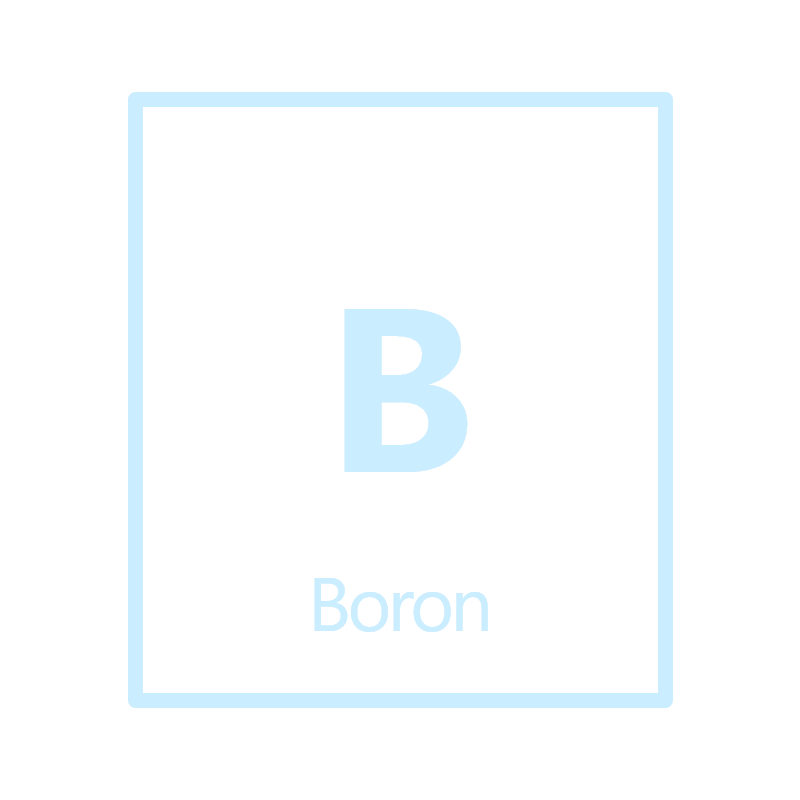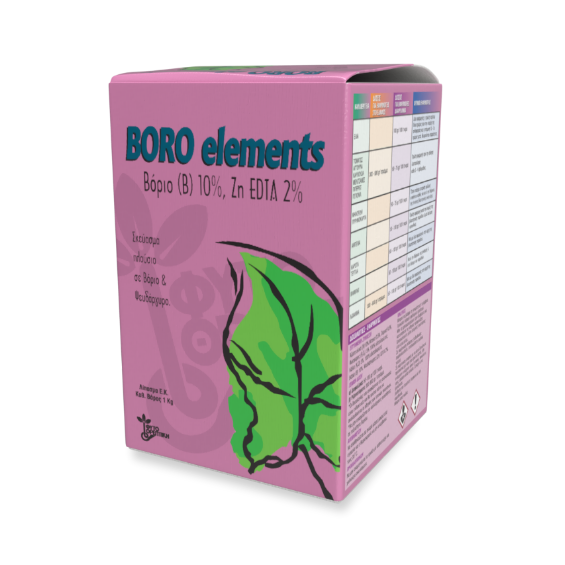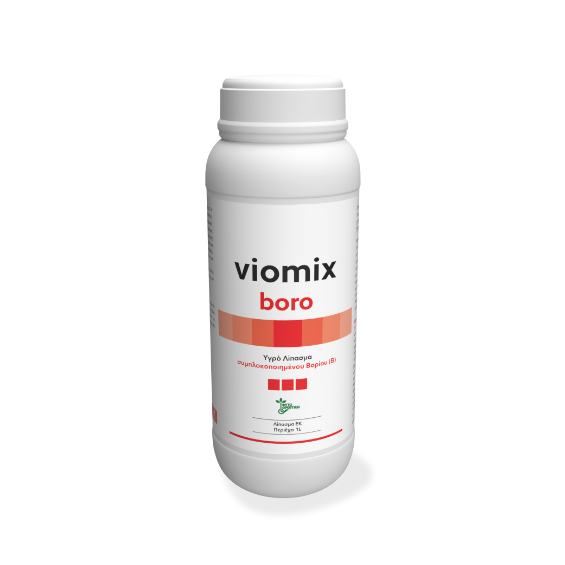
Boron (B) is considered one of the most important trace elements for plant growth. It regulates cell division, the transfer of sugars to the desired attraction centres, fruit growth and endogenous hormone biosynthesis regulation. It is also an essential component of cell walls. Its deficiency can disrupt the smooth operation of the above processes and ultimately deteriorate both yield and quality. In spite of the great need for this crucial nutrient, boron (B) deficiency is considered the second most widespread problem of trace element deficiency after zinc (Zn), worldwide.
1. Basic functions of boron
The most important functions of boron (B) in plants are its structural role in the composition and stability of cell walls and membranes. It also plays an important role in the activation or inhibition of certain metabolic pathways. Researchers claim that more than 90% of the total boron (B) in plants is found within the cell walls. The development of the cell wall requires the continuous supply of boron, as the greatest percentage of the element in the plants is found in a form which is unavailable to support growing cells. Boron deficiency negatively affects the plasticity of newly divided cells, thus reducing their growth capacity.
Boron is also considered an essential element for areas of growth of new plant organs and tissues, such as root tips, buds, new stems and flowers. According to researchers, boron is much more needed in meristems than in mature tissues. This is why the first effect of boron deficiency usually occurs in meristematic regions first. Boron deficiency has very important effects on the reproductive development (stamens, pollen, pollination, fertilisation, fruit growth).
Boron is also involved in nitrogen stabilisation. Under conditions of boron deficiency, both the number of tubercles and the nitrogen stabilisation capacity in legumes are reduced. Research shows that sufficient boron (B) improves the uptake of phosphorus (P) and potassium (K) and, additionally, enhances mycorrhizal symbiosis. Finally, boron is involved in numerous physiological functions. These include enzyme activation, the metabolism of carbohydrates, RNA, indolylacetic acid (IAA) and phenolic components, respiration, and the function of photosynthesis.
2. Mobility
Boron (B) is a mobile element within the ground; because it is required in small quantities, it is important to distribute it as evenly as possible in the field. Our company has developed a complete set of fertilisers that include boron (B), in order to achieve a uniform distribution. pH and mechanical composition are factors that significantly affect the element’s availability. Boron deficiency is particularly prevalent in sandy, acidic soils that are low in organic matter, due to its high flushing potential. Dry soils also present reduced mobility.
Within the plant, boron is an element with low mobility. Consequently, it cannot be adequately transferred to the reproductive organs. Due to the reduced mobility, maintaining soluble boron in the soil solution during all stages of plant growth, especially during flowering and fruit set, is important for optimal plant nutrition.
Environmental factors that reduce transpiration (e.g., drought, high atmospheric humidity and low soil moisture) have adverse effects on boron transport within the plant.
3. Boron deficiency
The morphological and physiological changes caused by the lack of boron suggest that this element plays a central role in the growth of higher plants. Boron is an element with low mobility. Therefore, under deficiency conditions, the first organs affected are the younger leaves, which lose their colour (rich dark color) and are dried. Drying starts at the base of the leaf lamina. Also, the extreme meristems of the shoots and the root system die off; this results in the leaves appearing thicker and with a smaller surface and in the production of a limited and arbuscular root system. In addition, the following have been observed under conditions of boron deficiency:
- Shortened internodes.
- Increased branching.
- Blossom drop.
- Fruit drop.
- Deterioration in quality
4. Examples in crops
Boron is the most important trace element in the olive tree (Olea europaea) and the most necessary for the development of flowering and fruit set. Its absence is the most common deficiency in the olive tree. It has an immediate effect, undermining the production capacity of the olive grove and significantly reducing yield.
Initially, boron deficiency causes the leaves and branches in the upper parts of the tree to fall off. At the same time, the leaves show a characteristic chlorosis on their apex, which may extend up to two thirds of the leaf surface. If the deficiency is not treated in time, the leaves turn completely yellow, with a characteristic brown colour at the apex and, eventually, fall. Even in cases of milder boron deficiency, some fruits may mature normally, but most will fall prematurely or be deformed.
The addition of boron during basal dressing of the olive tree is now considered necessary. Foliar spraying of boron during the formation stage of the new vegetation and at the beginning of flowering also show spectacular results.
In addition, crops, such as sugar beets, carrots, drupe s, vegetables, cotton, vines, and certain legumes, have high boron requirements. Legumes generally have higher boron requirements than grasses.
In boron-deficient apples and tomatoes, suberised material is formed.
5. Tips for preventing boron deficiency
Firstly, we suggest that you conduct a soil analysis of your field every two years, so that you have a complete picture of the nutrient levels. Compare your yield goals with the availability of your nutrients and discuss the available options with your agronomist. Because there is a fine line between nutrient deficiency and toxicity, it is important to apply the right amount of boron, at the right rate, always using the right product.

BORO elements® is a specialized product with boron (B) – zinc (Zn) – nitrogen (N) – phosphorus (P) and potassium (K); it ensures uniform distribution of the above nutrients. It is 100% water-soluble and contains boron in the form of sodium borate and chelated EDTA zinc (Zn), so as to ensure maximum absorption during its application. It is suitable for both foliar applications and fertigation.

VIOMIX B® is an ideal foliar fertiliser for all crops that are demanding in boron, as it contributes to the achievement of a balanced nutrition. It contains high concentrations of boron in the form of an organic complex, a highly bioavailable form, which is a powerful means of addressing the problems arising from boron deficiency.

